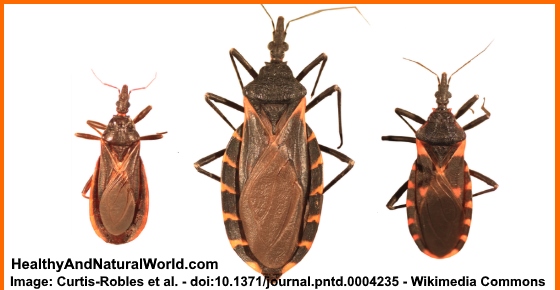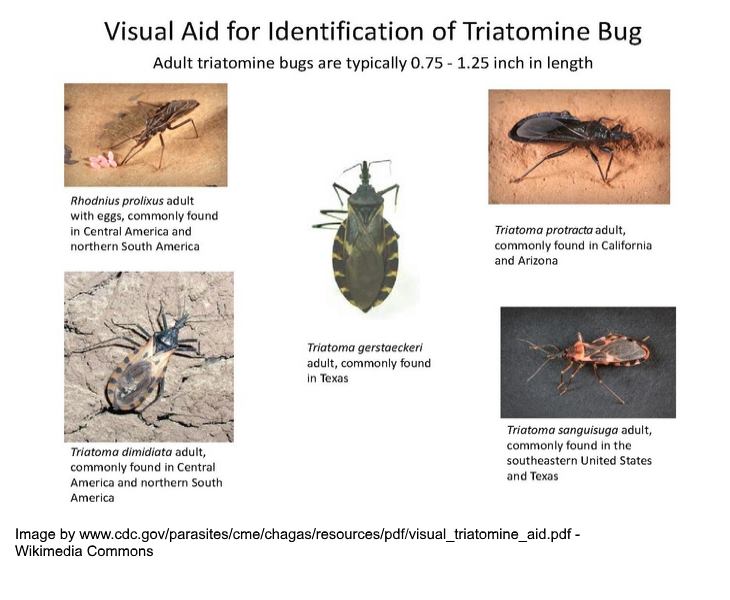‘Kissing Bug’ Spreads A Parasitic Disease in the U.S – They Bite People’s Face at Night

The triatomine bug, also called “the kissing bug”, is a dangerous creature that carries and transits parasites that can be harmful to your health. These critters are also called “Chagas bugs,” because the parasites that they are known to carry cause the dangerous Chagas disease.
Chagas disease can result in acute inflammatory skin changes and may eventually cause infection and inflammation of many other body tissues, especially those of the heart and intestinal tract.
Where are Kissing Bugs Commonly Found?
The kissing bug is usually not bigger than the size of a penny, around a half-inch or 1 centimeter. Found all over the world—and in the southern United States, Central and South America in particular—contact with these insects should be avoided at all costs. You can find the images of the kissing bug at the end of this article.
Kissing bugs—which can resemble to other harmless-to-humans bugs—are found in areas where “hiding places” are available. Look for them in nooks and crannies of your home and around your yard. If you have a cinder block wall, check the empty spaces.
Keep a particular eye on outdoor-located dog houses and chicken coops to keep pets and livestock safe. Wood piles, natural crevices, and other dark, enclosed areas where small insects may hide are ideal spots to find kissing bugs.
South and Central America as well as southern U.S. are all places where these insects commonly hide out, so be on guard if you live in these areas.
If you find a kissing bug in your home, capture it in an airtight container and cover it with rubbing alcohol. Then contact an insect identification unit and/or the CDC to report your finding.
Chagas Disease – What is it?
Chagas disease (also termed American trypanosomiasis) is an infection caused by a protozoan parasite (Trypanosoma cruzi) that can result in acute inflammatory skin changes (chagomas) and eventually may cause infection and inflammation of many other body tissues, especially those of the heart and intestinal tract.
The disease may have three phases in an individual:
Acute, with mild or no symptoms that may last weeks to about two months.
Intermediate or indeterminate phase that has few if any symptoms and may last 10-20 years or longer.
Chronic phase that appears after about 20 years, with the more severe symptoms appearing from gradual chronic organ damage (especially to the heart and intestine, although other organs may be affected) with symptoms that usually remain for life.
People with Chagas disease seen in the U.S. usually have acquired it while living in a country where the disease is endemic (Mexico and Central and South America).
Chagas Disease – Symptoms to Watch For
If you notice unusual swelling of your eyelid (especially upon waking) accompanied by a bug bite and you live in one of the Chagas-prone areas of the world, go to see a doctor. This symptom is called Romaña sign.
Other symptoms of Chagas disease may be swelling or redness of the bitten area, rash, swollen lymph nodes, fever, head and body aches, fatigue, nausea, vomiting, diarrhea, as well as liver or spleen enlargement.
Keep a lookout for the site of a parasitic entry on your body if you live in a kissing-bug area.
If you see any unusual raised lumps on your flesh, have them checked out by a physician. Most importantly, if you see an insect that looks like a kissing bug on your skin, contain it in rubbing alcohol and see a physician as soon as possible to rule out Chagas disease and parasite infestation.
How to Prevent Kissing Bugs From Entering Your Home
Just as you would to prevent any other sort of bug infestation, take preventive measures to keep these fiendish kissing bugs out of your home.
Seal any crevices and cracks, keeping a special eye out around wall seams, door frames, and windowsills.
Keep any piled objects (wood, stone, concrete) away from the outer walls of your home—try an outer fence area instead.
Keep doors and windows screened, and keep screens in good repair—watch for holes and snags.
Do not allow household pets to sleep outdoors at night. Keep chicken coops and other outdoor-animal living quarters in good repair, as you would your own home.
Keep tidy and avoid using outdoor lights if possible—kissing bugs, like moths, love well-lit areas.
Visual Aid Identification of the Kissing Bug
Related articles:
1. How to Get Rid of Roaches Naturally and Easily
2. How to Get Rid of Ants Cheaply and Naturally
3. How to Get Rid of Flies Naturally
Resources:

